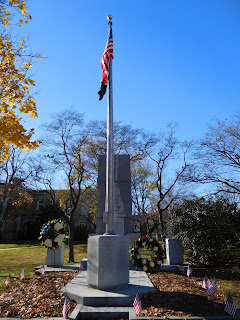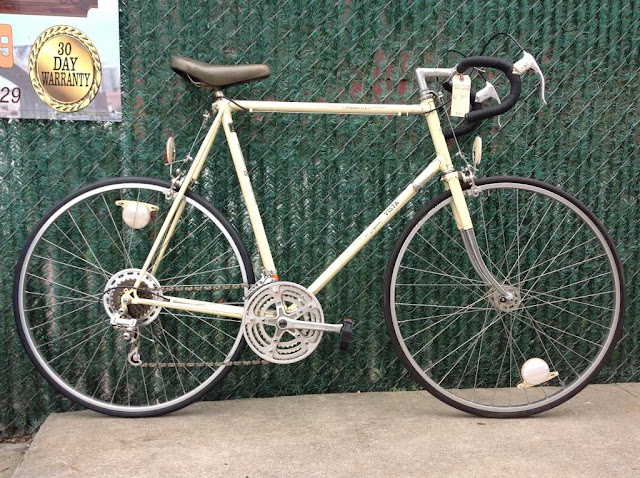Days like today induce cognitive dissonance. The temperature would have been right a month or more ago: about 17C (64F). Not that I was complaining: of course I went for a ride.
What I saw, though, reminded me that fall is tipping toward winter. Not that I was complaining about that, either: Some of the sights were quite lovely in sensual as well as more austere ways.
I pedaled to Connecticut, for the 20th time this year. There, the signs that fall is leaving us were even more visible.
This memorial to Greenwich residents who died in World War II, Korea and Vietnam seems even more like a memorial with the bare trees behind it than it does during the spring or summer, when everything is budding or in bloom, or during early or mid-fall. I am willing to visit such monuments, not to celebrate victories, actual or perceived heroism or other exploits, but to remember what a tragedy it is that people die--and others' lives are ruined--over conflicts that are never resolved, no matter how many young people sacrifice themselves to the siren call that echoes Dulce et decorum est pro patria mori.
Anyway, my ride was most satisfying. It might be the last Connecticut ride I take this season. If it turns out to be so, I would be satisfied: I felt good, and the bike--Arielle, my Mercian Audax--glided over the roads and paths.
While I was sitting by the memorial, a woman walking by stopped to admire my bike. Then she got a glimpse of me. Omigod, how are you doing? She was a student of mine last year; now she is working, ironically, at Greenwich Hospital. And, near the end of my ride, I got a glimpse of a young guy who, it turned out, is a current student of mine. It took a moment for us to recognize each other because, I guess, we were "out of context". I was not in the sort of clothes I wear to work, and he had shaved his goatee since I last saw him--yesterday.
Funny thing is, I chastised him last week about something. I never had to do that to the my former student whom I saw today in Connecticut. But they were both happy to see me, I think. Maybe it's because I was having such a good ride.
What I saw, though, reminded me that fall is tipping toward winter. Not that I was complaining about that, either: Some of the sights were quite lovely in sensual as well as more austere ways.
I pedaled to Connecticut, for the 20th time this year. There, the signs that fall is leaving us were even more visible.
This memorial to Greenwich residents who died in World War II, Korea and Vietnam seems even more like a memorial with the bare trees behind it than it does during the spring or summer, when everything is budding or in bloom, or during early or mid-fall. I am willing to visit such monuments, not to celebrate victories, actual or perceived heroism or other exploits, but to remember what a tragedy it is that people die--and others' lives are ruined--over conflicts that are never resolved, no matter how many young people sacrifice themselves to the siren call that echoes Dulce et decorum est pro patria mori.
Anyway, my ride was most satisfying. It might be the last Connecticut ride I take this season. If it turns out to be so, I would be satisfied: I felt good, and the bike--Arielle, my Mercian Audax--glided over the roads and paths.
While I was sitting by the memorial, a woman walking by stopped to admire my bike. Then she got a glimpse of me. Omigod, how are you doing? She was a student of mine last year; now she is working, ironically, at Greenwich Hospital. And, near the end of my ride, I got a glimpse of a young guy who, it turned out, is a current student of mine. It took a moment for us to recognize each other because, I guess, we were "out of context". I was not in the sort of clothes I wear to work, and he had shaved his goatee since I last saw him--yesterday.
Funny thing is, I chastised him last week about something. I never had to do that to the my former student whom I saw today in Connecticut. But they were both happy to see me, I think. Maybe it's because I was having such a good ride.













